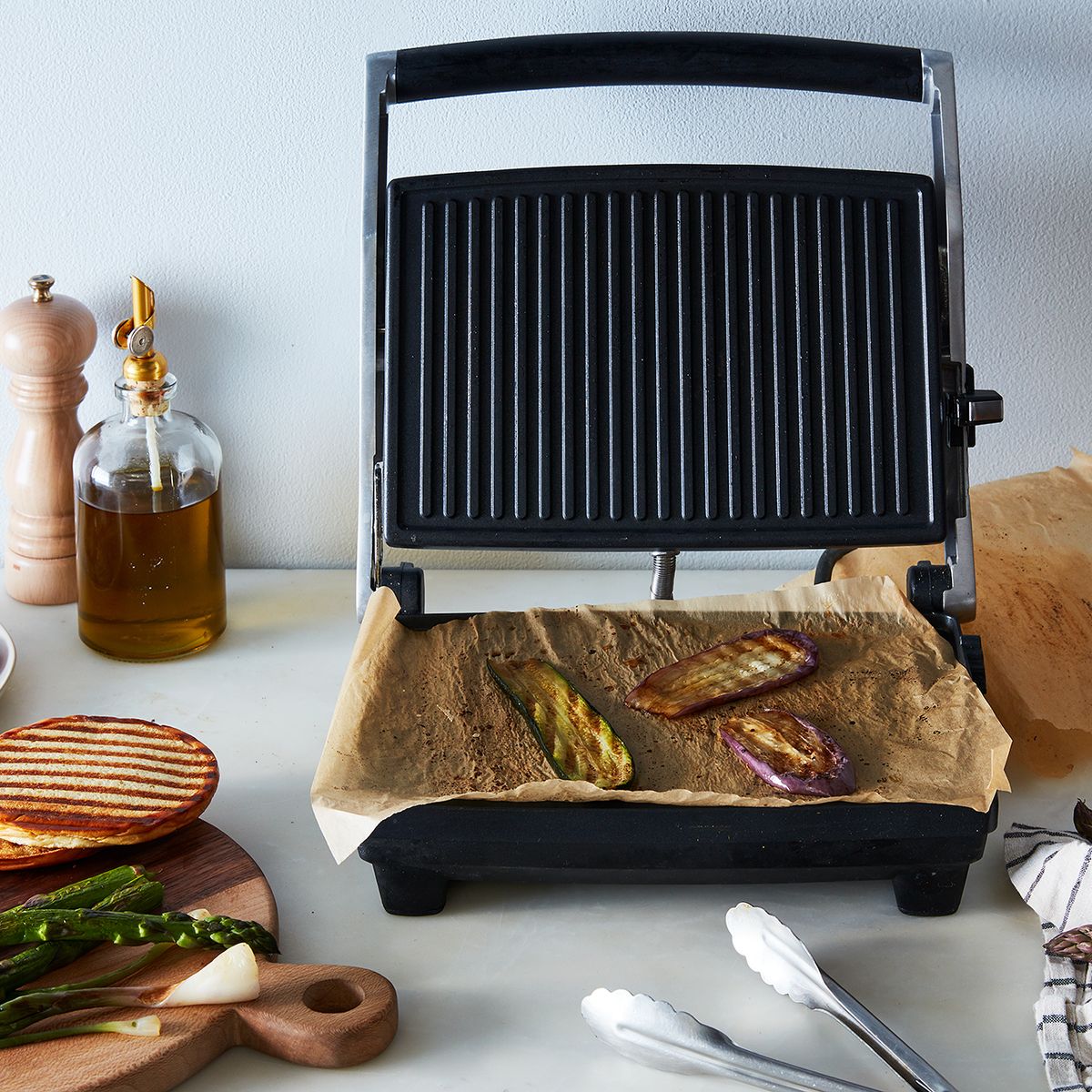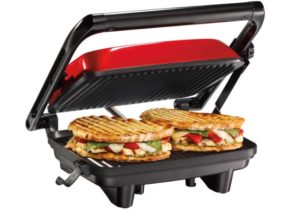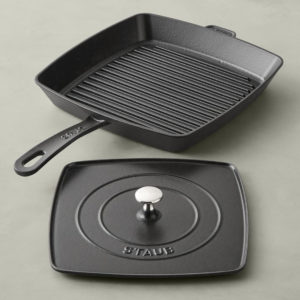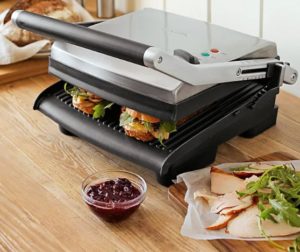A panini press is a versatile kitchen appliance that is used to make hot, crispy sandwiches. It consists of two heated plates that can be pressed together to grill and toast bread, cheese, meat, vegetables, and other ingredients.
With a panini press, you can create a variety of delicious and customized sandwiches in minutes, making it a popular choice for quick and easy meals. Whether you’re a sandwich lover or looking for a way to upgrade your cooking skills, a panini press can be a great addition to your kitchen appliances.
Why is it called panini press?
The word “panini” comes from Italian, and it means “small bread rolls.” Panini sandwiches, which originated in Italy, are made with small rolls that are filled with various ingredients and grilled to perfection. A panini press is a specialized kitchen appliance designed to make these sandwiches by pressing them together and heating them from both sides. The term “panini press” simply refers to the appliance used to make these sandwiches.
What is special about a panini press?
A panini press is a specialized kitchen appliance designed to make panini, a type of grilled sandwich originating from Italy. What makes a panini press special is its ability to press and grill the sandwich, creating a crisp exterior and warm, melty interior.
The press is often made with ridges that leave grill marks on the bread and can be used to cook a variety of sandwich ingredients, from meats and cheeses to vegetables and spreads. The heat is evenly distributed from both the top and bottom plates, ensuring that the sandwich is cooked thoroughly and quickly.
Additionally, the press can often be adjusted for different sandwich thicknesses and can be used to toast or heat other types of bread-based dishes, such as quesadillas or flatbreads.
What can you use a panini press for?
A panini press can be used for a variety of foods and cooking techniques. Here are some common uses for a panini press:
- Making sandwiches: A panini press can be used to make a wide range of sandwiches, from classic grilled cheese to more elaborate creations like turkey and avocado or caprese.
- Grilling meats and vegetables: You can use a panini press to cook chicken, steak, fish, and vegetables like zucchini or eggplant. The press creates grill marks and sears the food, giving it a crispy exterior and juicy interior.
- Making quesadillas: A panini press is a great tool for making crispy and melty quesadillas. Just fill a tortilla with cheese, meat, vegetables, or beans, and press it until it’s golden and crispy.
- Cooking bacon: A panini press can also be used to cook bacon quickly and evenly, without the need for a frying pan or griddle.
- Making desserts: You can use a panini press to make desserts like grilled fruit, waffles, or French toast. The press creates a crispy crust while keeping the inside soft and fluffy.
- Overall, a panini press is a versatile kitchen appliance that can be used for a variety of foods and cooking techniques.
What is the difference between a panini press and a sandwich press?
A panini press and a sandwich press are similar in function, but there are a few key differences between the two.
- Size and shape: Panini presses are generally larger and have a wider cooking surface than sandwich presses. They are designed specifically for making paninis, which are typically larger and thicker than traditional sandwiches. Sandwich presses, on the other hand, are usually smaller and have a more compact cooking surface, which is better suited for making smaller sandwiches.
- Cooking surface: Panini presses have ridged cooking surfaces that create grill marks on the bread, while sandwich presses have smooth surfaces that press the bread together evenly. The ridges on a panini press also allow excess oil and fat to drain away from the food, making it healthier.
- Versatility: While a panini press is primarily designed for making paninis, it can also be used for grilling meats and vegetables, cooking bacon, and making other types of sandwiches. A sandwich press, on the other hand, is generally limited to making smaller sandwiches.
- Price: Panini presses tend to be more expensive than sandwich presses, due to their larger size and more versatile functionality.
Overall, if you plan to make a lot of paninis or want a more versatile appliance, a panini press might be the better choice. However, if you only plan to make smaller sandwiches, a sandwich press might be more suitable for your needs.
What's the difference between griddle and panini?
A griddle and a panini press are two different types of cooking appliances. A griddle is a flat cooking surface that is typically made of cast iron or another type of metal. It is used to cook a variety of foods such as pancakes, eggs, bacon, and burgers.
A panini press, on the other hand, is a cooking appliance that is specifically designed to make panini sandwiches. It consists of two heated plates that are hinged together and can be used to press and grill the sandwich, creating a crisp and melty texture. While both appliances can be used to cook sandwiches, a griddle is more versatile and can be used for a wider range of foods, while a panini press is designed specifically for making paninis.
What is the difference between a panini and a toastie?
Both paninis and toasties are types of grilled sandwiches, but there are a few differences between the two:
- Bread: Paninis are typically made with ciabatta or another type of Italian bread that is sturdy enough to hold up to grilling. Toasties, on the other hand, are usually made with sliced bread.
- Pressing: A panini is grilled using a panini press, which presses the sandwich between two heated plates. A toastie is usually made in a regular sandwich press or on a stovetop griddle, without the pressing action.
- Filling: Paninis are often filled with a variety of ingredients, including meats, cheeses, and vegetables. Toasties tend to have simpler fillings, such as cheese and ham or tomato and cheese.
- Cooking time: Because of the differences in bread and cooking method, paninis generally take longer to cook than toasties. A panini may take several minutes to grill, while a toastie can be ready in just a couple of minutes.
Are panini presses non stick?
Many panini presses are designed with a non-stick coating on the cooking surface, which helps prevent the sandwich from sticking to the plates and makes cleaning up easier. However, not all panini presses have a non-stick coating, so it’s important to check the product specifications before purchasing one.
Some models may have a ceramic or cast-iron cooking surface, which can provide better heat distribution and sear, but may require more maintenance to keep the surface from sticking.
Can I use a panini press as a grill?
Yes, a panini press can be used as a grill for various types of food, such as chicken, fish, vegetables, and even fruits. However, it is important to keep in mind that the cooking surface of a panini press is typically smaller than that of a regular grill, so you may need to cook food in smaller batches or cut it into smaller pieces to fit on the press. Additionally, some panini presses may not have adjustable temperature settings, so you may need to monitor the cooking closely to prevent overcooking or undercooking.
Do panini presses need oil?
It depends on what you are cooking on the panini press. For some foods, such as sandwiches, you may not need to use oil as the bread already contains some oil or butter. However, if you are cooking foods that tend to stick, like chicken or fish, you may want to lightly oil the cooking surface of the panini press to prevent sticking. It is important to use oil sparingly and choose a high smoke point oil, such as canola or grapeseed oil, to avoid smoke or burnt flavors. Always refer to the manufacturer’s instructions for your specific panini press to ensure proper usage and maintenance.
Can you use regular bread for panini?
Yes, you can use regular bread for panini. In fact, most panini recipes call for regular bread, such as ciabatta, sourdough, or French bread. The key to making a good panini is to choose a bread that is sturdy enough to hold up to the filling and can be compressed without falling apart. You can also use other types of bread, such as pita or flatbread, for a variation on the traditional panini. Just make sure to adjust the cooking time and temperature accordingly to ensure that the bread is toasted and the filling is heated through.
What is the best cheese for paninis?
There are many types of cheese that can work well in a panini, depending on personal taste preferences. Some popular choices include:
- Mozzarella: This cheese has a mild flavor and melts easily, making it a great option for paninis.
- Provolone: Provolone has a tangy flavor and is also a good melting cheese. It pairs well with meats like ham or turkey.
- Cheddar: Cheddar has a sharp flavor and adds a nice contrast to the other ingredients in a panini.
- Gouda: Gouda has a nutty flavor and melts well. It pairs well with ingredients like bacon or roasted vegetables.
- Brie: Brie has a soft, creamy texture and a mild flavor. It pairs well with ingredients like sliced apples or prosciutto.
Ultimately, the best cheese for a panini is a matter of personal preference, so feel free to experiment with different types of cheese to find your favorite combination.
What is pros and cons of using panini press?
- Versatility: a panini press can be used to make a variety of hot sandwiches, grilled vegetables, meats, and even desserts.
- Convenience: panini presses are easy to use and can quickly produce a hot, crispy sandwich in just a few minutes.
- Even cooking: the top and bottom plates of a panini press provide even heat distribution, which helps to ensure that the sandwich is cooked evenly on both sides.
- Healthier cooking: panini presses can be used to grill sandwiches without the need for additional oil or butter, making them a healthier cooking option.
- Limited space: the size of the cooking surface on a panini press is limited, so it may not be able to accommodate larger sandwiches or larger quantities of food.
- Can be difficult to clean: the ridged plates of a panini press can make it difficult to clean thoroughly, especially if food gets stuck in the crevices.
- Can be expensive: high-quality panini presses can be more expensive than other types of cooking appliances, which may not be ideal for budget-conscious consumers.
Overall, the pros of using a panini press, such as versatility and convenience, outweigh the cons, making it a popular and useful kitchen appliance.
Can you put dough in panini press?
It is not recommended to put raw dough directly in a panini press as it can cause the press to get messy and may not produce desirable results. However, you can use the panini press to grill pre-made or pre-cooked dough such as pizza dough, flatbread, or naan bread. It can give the dough a crispy texture and add grill marks for a more visually appealing result.
How long to leave panini in press?
The length of time to leave a panini in the press depends on the thickness of the bread and the ingredients inside. As a general guideline, a panini should be left in the press for 3-5 minutes or until the bread is golden brown and the cheese is melted (if using). It’s best to check the panini frequently to avoid burning.
How do you flatten a panini without a press?
To flatten a panini without a press, you can try using a heavy skillet or a cast-iron pan. Preheat the pan over medium-high heat and place the panini on the skillet. Then, place another heavy skillet or a heavy object like a foil-wrapped brick on top of the panini to apply pressure.
Cook the panini for a few minutes until it is crispy and golden brown, then flip it over and repeat the process. Keep in mind that this method may not produce the same level of even compression and grill marks as a panini press.
What temperature do you press a panini?
The optimal temperature to press a panini depends on the type of bread and fillings you are using. However, in general, most panini presses have a temperature range between 300°F to 450°F (149°C to 232°C). It’s best to follow the manufacturer’s instructions for your specific panini press and adjust the temperature according to the recipe or your preference.
How to use panini press
Here are some general steps for using a panini press:
- Preheat the press: Turn on the panini press and let it heat up for a few minutes, until it reaches the desired temperature.
- Prepare the bread and fillings: Choose the bread you want to use for your panini and slice it as desired. Then, add your desired fillings, such as cheese, meat, vegetables, or spreads.
- Assemble the panini: Put your filling between two slices of bread to make a sandwich.
- Place the panini on the press: Open the press and place your panini inside. Make sure it is positioned in the center of the press.
- Close the press: Gently close the lid of the panini press over the sandwich.
- Cook the panini: Let the panini cook for a few minutes, depending on the desired level of crispness and meltiness.
- Serve the panini: Once the panini is cooked to your liking, remove it from the press and let it cool for a minute or two. Then, slice it in half and serve. Enjoy your delicious panini!
It is important to read the instructions that come with your specific panini press, as cooking times and temperature may vary depending on the model.
How to clean panini press
Cleaning a panini press is important to ensure its longevity and maintain good hygiene. Here are the steps to clean a panini press:
- Unplug the panini press and let it cool down completely.
- Use a damp cloth or sponge to wipe off any food debris on the plates and the exterior of the machine.
- If there is a lot of stubborn food residue, use a plastic scraper or spatula to remove it. Avoid using metal utensils that may scratch the non-stick coating.
- For tougher stains, you can use a mixture of baking soda and water to create a paste. Apply the paste on the plates and let it sit for a few minutes before wiping it off.
- For the exterior, you can use a mild cleaning solution or a mixture of vinegar and water to wipe it down.
- Once everything is clean, rinse the cloth or sponge with clean water and wipe down the machine to remove any cleaning solution or residue.
- Let the panini press dry completely before using it again.
It’s important to read the manufacturer’s instructions for specific cleaning recommendations for your panini press, as some models may have different cleaning instructions.
How to maintain panini press properly
Maintaining your panini press properly can help prolong its lifespan and keep it functioning effectively. Here are some tips on how to maintain your panini press properly:
- Unplug the press and allow it to cool before cleaning.
- Wipe the plates and the exterior of the press with a damp cloth to remove any food debris.
- For tougher stains or baked-on grease, you can use a mixture of water and mild detergent to scrub the plates with a soft-bristled brush.
- Avoid using abrasive cleaners or metal utensils that can scratch the non-stick surface of the plates.
- Remove excess oil and grease by wiping the plates with a paper towel or cloth after each use.
- Store the panini press in a cool, dry place to prevent rust or other damage.
- Check the cord for any damage or wear and tear. If you notice any, do not use the press until it has been repaired.
- Regularly inspect the press for loose screws, hinges or any other parts that may need tightening or replacing.
By following these maintenance tips, you can ensure that your panini press remains in good condition and delivers consistent and delicious results every time you use it.
Conclusion
In conclusion, a panini press is a versatile kitchen appliance that can be used to make delicious, hot sandwiches quickly and easily. It can be used with a variety of breads and fillings, and the possibilities for customization are endless. Some of the pros of a panini press include its versatility, ease of use, and speed, while some of the cons include its limited capacity and the fact that it can be difficult to clean. Overall, if you enjoy making hot sandwiches and are looking for a convenient and efficient way to do so, a panini press may be a good investment for your kitchen.
Related Products
Hamilton Beach Panini Press
With the Hamilton Beach Panini Press Gourmet Sandwich Maker, you...
Read MoreBest Cast Iron Panini Press For Quick And Easy Grilling
Disclaimer: There are affiliate links in this post. At no...
Read MoreWhat Is The Best Panini Press To Buy
Disclaimer: There are affiliate links in this post. At no...
Read MoreWhy Trust Us
You will find what you are looking for at dulceriabakery. From classic to luxury brands, you'll find both. We will help you to select appliances that fit your needs, budget and lifestyle. Whether you want to stop by to learn more — or plan to make a major purchase — we’ll treat you like family and assist you every step of the way. Shop with us today to receive friendly and experienced help along the way.




